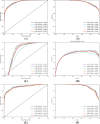Herb-disease association prediction model based on network consistency projection
- PMID: 39865145
- PMCID: PMC11770172
- DOI: 10.1038/s41598-025-87521-7
Herb-disease association prediction model based on network consistency projection
Abstract
A growing number of biological and clinical reports indicate the usefulness of herbs in the treatment of complex human diseases, giving an essential supplement for modern medicine. Similar to drugs, the use of experimental validation to identify related diseases of given herbs is both expensive and time-consuming. Such validation is even more difficult because each herb always contains several components. It is alternative to design computational models to predict herb-disease associations (HDAs). Nevertheless, only a few computational models have been developed for HDA prediction. In this study, we make full use of several properties of herbs and diseases, which are collected in a public database HERB, to design a model named HDAPM-NCP for predicting HDAs. Based on these properties, six herb kernels and five disease kernels are constructed, which are further fused into one unified herb kernel and one disease kernel. These kernels and herb-disease adjacency matrix are fed into network consistency projection to quantify the strength of herb-disease pairs. The cross-validation results show the high performance of HDAPM-NCP. Such performance is higher than that of two previous models. The ablation experiments prove the effects of modules in this model. Finally, we also analyze the weakness and strength of the model, uncovering which herb-disease pairs that HDAPM-NCP can yield reliable or unsatisfied predictions, and a case study is conducted to prove that HDAPM-NCP can discover latent HDAs.
Keywords: Disease; Herb; Herb-disease association; Network consistency projection.
© 2025. The Author(s).
Conflict of interest statement
Declarations. Competing interests: The authors declare no competing interests.
Figures






Similar articles
-
Assessing the comparative effects of interventions in COPD: a tutorial on network meta-analysis for clinicians.Respir Res. 2024 Dec 21;25(1):438. doi: 10.1186/s12931-024-03056-x. Respir Res. 2024. PMID: 39709425 Free PMC article. Review.
-
A rapid and systematic review of the clinical effectiveness and cost-effectiveness of paclitaxel, docetaxel, gemcitabine and vinorelbine in non-small-cell lung cancer.Health Technol Assess. 2001;5(32):1-195. doi: 10.3310/hta5320. Health Technol Assess. 2001. PMID: 12065068
-
Signs and symptoms to determine if a patient presenting in primary care or hospital outpatient settings has COVID-19.Cochrane Database Syst Rev. 2022 May 20;5(5):CD013665. doi: 10.1002/14651858.CD013665.pub3. Cochrane Database Syst Rev. 2022. PMID: 35593186 Free PMC article.
-
Systemic pharmacological treatments for chronic plaque psoriasis: a network meta-analysis.Cochrane Database Syst Rev. 2021 Apr 19;4(4):CD011535. doi: 10.1002/14651858.CD011535.pub4. Cochrane Database Syst Rev. 2021. Update in: Cochrane Database Syst Rev. 2022 May 23;5:CD011535. doi: 10.1002/14651858.CD011535.pub5. PMID: 33871055 Free PMC article. Updated.
-
Personal protective equipment for preventing highly infectious diseases due to exposure to contaminated body fluids in healthcare staff.Cochrane Database Syst Rev. 2016 Apr 19;4:CD011621. doi: 10.1002/14651858.CD011621.pub2. Cochrane Database Syst Rev. 2016. Update in: Cochrane Database Syst Rev. 2019 Jul 01;7:CD011621. doi: 10.1002/14651858.CD011621.pub3. PMID: 27093058 Free PMC article. Updated.
Cited by
-
Machine Learning Identifies Key Gene Markers Related to Fetal Retina Development at Single-Cell Transcription Level.Invest Ophthalmol Vis Sci. 2025 Jun 2;66(6):60. doi: 10.1167/iovs.66.6.60. Invest Ophthalmol Vis Sci. 2025. PMID: 40531615 Free PMC article.
-
Transcriptomic and miRNA Signatures of ChAdOx1 nCoV-19 Vaccine Response Using Machine Learning.Life (Basel). 2025 Jun 18;15(6):981. doi: 10.3390/life15060981. Life (Basel). 2025. PMID: 40566633 Free PMC article.
-
Unveiling Immune Response Mechanisms in Mpox Infection Through Machine Learning Analysis of Time Series Gene Expression Data.Life (Basel). 2025 Jun 30;15(7):1039. doi: 10.3390/life15071039. Life (Basel). 2025. PMID: 40724541 Free PMC article.
-
Machine learning approaches reveal methylation signatures associated with pediatric acute myeloid leukemia recurrence.Sci Rep. 2025 May 6;15(1):15815. doi: 10.1038/s41598-025-99258-4. Sci Rep. 2025. PMID: 40328883 Free PMC article.
References
MeSH terms
LinkOut - more resources
Full Text Sources

